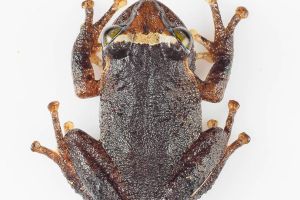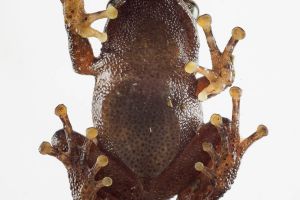
Frogs of Borneo

Frogs of Borneo

Frogs of Borneo

Frogs of Borneo

Frogs of Borneo

Frogs of Borneo

Frogs of Borneo

Frogs of Borneo

Frogs of Borneo

Frogs of Borneo

Frogs of Borneo
Bornean Families
Philautus:
saueri
Sauer’s Bush Frog
Philautus saueri is a highland species known from Gunung Kinabalu. It was first described by Malkmus and Riede (1996) in German. The type locality is given as east of Pakka Cave, at 3050 m a.s.l., Gunung Kinabalu, Sarawak.
This species has rarely been documented with certainty. Consequently, the following description relies primarily on the holotype. Males reach 22 mm in snout–vent length (female unknown). The forehead is concave in profile. The canthus rostralis is indistinct. The eardrum is visible but indistinct. A distinct, strongly curved supratympanic fold extends from the eye to the armpit. When the hindlimb is adpressed forward along the body, the heel reaches the level of the snout tip. All digits bear transversely oval adhesive discs. The dorsal skin is relatively smooth. A small conical tubercle is present at the heel. The pupil is horizontal and oval.
The coloration of the type specimen was blackish brown dorsally, densely stippled with whitish dots. A yellowish-white crossbar between the eyes separated the reddish-brown snout from the blackish-brown dorsum. A white blotch was present below the eye. The ventral surface was white with brown reticulation. The central part of the iris was greyish brown with darker reticulations and yellow-green margins. Little is known about the variability of this species, but highly variable color patterns can be expected.
At higher elevations of Kinabalu, from 2200–2500 m a.s.l., Philautus saueri occurs syntopically with P. amoenus. Both species are morphologically similar, and their calls likely provide the most reliable distinguishing feature. Malkmus and Riede (1996) noted that P. saueri is unique among the Philautus species of Gunung Kinabalu in that it also calls during the day, whereas all others are strictly nocturnal. The authors reported finding dead pitchers of Nepenthes villosacontaining eggs they attributed to P. saueri. The eggs measured 11–15 mm in diameter (including the jelly). Although Malkmus et al. (2002) referred to them as “tadpoles,” a photograph in that publication suggests that the embryos may instead be described as direct-developing embryos.
The call of Philautus saueri consists of a series of 2–4 pulsed notes.
Version tracking
-
30.10.2025
updated


